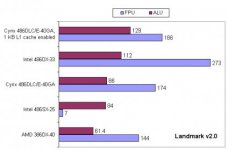OK now, I've thrown everything I could to my 386 PC. It is now like:
CPU: 80386DX-40 (AMD) / 80387DX (IIT3C87-40)
Mainboard: 4386-VC-HD ( http://stason.org/TULARC/pc/motherboards/U/UNIDENTIFIED-486-4386-VC-HD.html )
Cache: 128K L2 cache
RAM: 32 MB RAM 60ns non-parity ECC
Video card: Tseng Labs ET4000 W32, or S3 928
As you can see, everything is the most advanced I can fit in, apart from the cache, where I tried to add another 128K (from a 486 board) but couldn't get a stable system. The PC still gets its ass handed to it performance wise, compared to a Pentium 133MHz, S3 Trio 64V+ card, 70ns RAM that I have. I was hoping that all these upgrades would somehow bridge the gap, but I guess I was wrong, as the performance difference is still so big that it is obvious without even the need to run a benchmark suit.
Actually, it is not quite it its most advanced configuration. A TI/Cyrix TX486DLC/E-40GA will certainly outperform an AMD 386DX-40. I have a similar system to yours except that I recently swapped my AMD 386DX-40 for a Cyrix TX486DLC/E-40GA. If you enable the 1 KB of L1 cache on the Cyrix, you really get a performance boost.

Please refer to the attached Landmark benchmark comparison, which compares the Cyrix TX486DLC/E-40GA with L1 cache on and off, as well as an AMD 386DX-40, Intel 486SX-25 and Intel 486DX-33. As is evident, the Cyrix TX486DLC/E-40GA performs like an Intel 486SX-25 in ALU operations if the L1 cache is disabled, but it will clobber the Intel 486DX-33 with the L1 cache enabled. This is a synthetic benchmark, so I'm not sure how the two CPUs will compare with a real world application. For FPU performance, my Cyrix TX486DLC/E-40GA system also had a generic 386-era FasMath chip installed, which was no match for the Intel486DX-33's built-in FPU.
In Windows 3.11, using WinPlay3, I was able to play 32 kbps mono mp3s on a 386-40Mhz (Cyrix CX486DLC) without skips or crackles.
I too couldn't get 256 KB of L2 cache stable on my motherboard, even though it has the jumper settings for it. So I am back at 128 KB of cache and 32 MB of RAM. The BIOS will correctly count the 32 MB of RAM, but Himem will not pass RAM check with more than 16 MB of RAM. I can bypass himem and got straight into Windows 3.11, but Windows will crash when it tries to access over 16 MB of RAM. I am wondering if you've run into this problem? Anybody have any ideas?
EDIT: So I originally attached a 6 KB high quality PNG file, but the forum posted it as a low quality, larger, 15 KB JPEG file. Is there any way to force the image to stay in its original, small, format?
Last edited:
